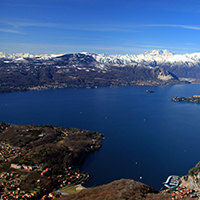Transparent exopolymer particles (TEP), phytoplankton and picocyanobacteria along a littoral-to-pelagic depth-gradient in a large subalpine lake

All claims expressed in this article are solely those of the authors and do not necessarily represent those of their affiliated organizations, or those of the publisher, the editors and the reviewers. Any product that may be evaluated in this article or claim that may be made by its manufacturer is not guaranteed or endorsed by the publisher.
Authors
Transparent exopolymer particles (TEP) play an important role in the organic carbon cycle of many aquatic systems but the production and distribution of TEP have been studied mainly in the marine environment, neglecting the large oligotrophic lakes. We selected Lake Maggiore, one of the most important freshwater reserve in Northern Italy, to study the horizontal and vertical distribution of TEP and of its possible drivers. Samplings along a transect in the Borromeo basin were performed in May, July and September 2019. Total Organic Carbon (TOC), TEP, chlorophyll-a (Chl) of different algal groups, picocyanobacteria, bacteria and eukaryotes counting, were measured at six stations and five depths. Our study showed that TEP exhibited a clear vertical heterogeneity from surface to the bottom related to the autotrophic microorganisms that are the main source of TEP and are prevalent in the euphotic zone of the lake. On the other hand, TEP was fairly evenly distributed along the horizontal transect from littoral to pelagic zone, although patches were present in spring, when TEP concentrations were low. In contrast to TEP, TOC and to a lesser extent Chl and bacteria showed horizontal heterogeneity, in some months. In Lake Maggiore TEP indeed was an important fraction of Total Organic Carbon (TOC), making up to 54% of TOC (in carbon units: 910 µg C L-1) and it was significantly correlated with Chl. The highest TEP concentration (1.44 mg GX eq L-1) was measured in September 2019, in coincidence with an episode of superficial foam appearance. Considering the biomass as Chl concentrations, the algal group mostly related to TEP was that of brown algae, particularly diatoms; but considering the numbers, the picocyanobacteria and bacteria were more significantly correlated to TEP. The presence of pennate diatoms in May and July, with their TEP-related chlorophyll, did not produce TEP in as high concentration as that observed in September in the presence of centric diatoms and of very high numbers of picocyanobacteria and bacteria.
How to Cite

This work is licensed under a Creative Commons Attribution-NonCommercial 4.0 International License.






